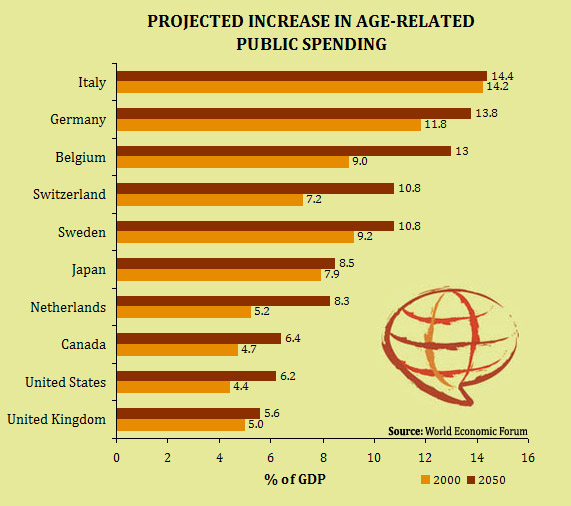
The elderly era
According to OECD projections by 2050 over 1970 million people will be older than 60 years old, what is to say about 21.7 percent of world’s population. This, according to the latest World Economic Forum report on the issue (they tend to do quite conservative diagnosis…), will cause some effects to the economy:
1. Old-age dependency rations will rise not only due to population ageing, but also because a decline in the labour force (as a result of the low fertility rate).
Of the world’s major regions, Europe had the highest old-age dependency ratio (24%) in 2007, and is also expected to be the oldest region in 2050, with an oldage dependency ratio of 48%. However, the UN predicts all regions will experience dramatic increases in the dependency ratio.
2. Significant pressure on pay-as-you-go (PAyG) public pensions and healthcare systems.
Due to rapid population ageing, cost-increasing medical technologies and higher incidences of chronic diseases.
3. Growing expectations that the private sector will come to the rescue.
As governments continue to struggle with rising pension and healthcare costs, further political reforms and a growing role for the private sector are likely to emerge. Pressure on employers to fund and facilitate healthcare for their employees will increase.
4. Lack of individual financial knowledge as a major policy concern.
A better understanding of savings and investment alternatives has become increasingly important due to the shift towards greater individual responsibility and personal choice in defined-contribution retirement schemes, especially in developed countries.
5. Growing prevalence of chronic diseases around the world.
According to the World Health Organization (2005), cardiovascular diseases (mainly heart disease and stroke) are the leading cause (30%) of death in the world. The WHO expects deaths from chronic diseases will increase by 17% between 2005 and 2015.
6. Lack of formal social security coverage.
According to the UN (2007), on average only 20% of populations in less-developed countries are covered by social security benefits.
7. Underdeveloped private-pension and health insurance markets.
According to the OECD (2006), pension markets in most non-OECD countries are at an early stage of development. The weighted average ratio of pension fund assets to GDP across 27 non-OECD economies was only 34% in 2005. By comparison, this ratio was 88% for the OECD area in 2005.
8. Double burden of infectious and chronic diseases.
Many less-developed countries have not yet adequately addressed public health goals such as mass vaccination. At the same time, they are confronted with rapid population ageing, which is leading to greater demands for healthcare services by older persons with chronic diseases.
¿Quieres recibir más explicaciones como esta por email?

